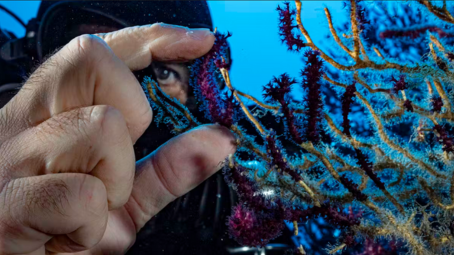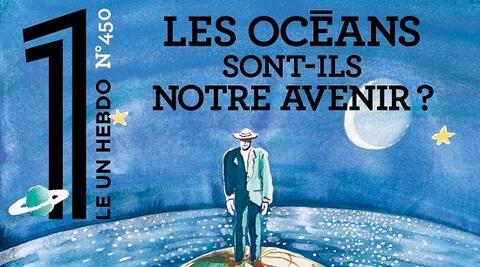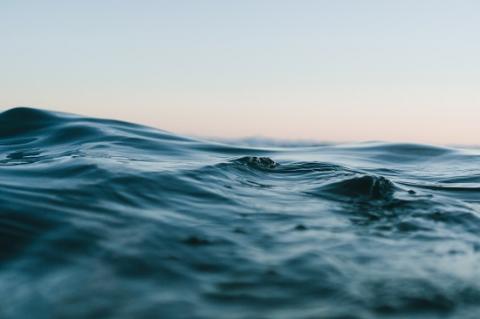
The Sea on Fire: the impact of marine heat waves on “soft coral” forests in the Mediterranean
Just as fires destroy forests of trees, marine heat waves "burn" gorgonian forests, resulting in the loss of an ecologically valuable habitat.Just as fires destroy forests of trees, marine heat waves "burn" gorgonian forests, resulting in the loss of an ecologically valuable habitat.
In this image, we can see the devastating effects of a marine heat wave on a Mediterranean red gorgonian (Paramuricea clavata) forest. Just as forests are destroyed by fire, marine heat waves "burn" these gorgonian forests, resulting in the loss of an ecologically valuable habitat.
Gorgonians are corals, i.e. animals (not plants) made up of hundreds of tiny polyps with stinging tentacles that capture their prey in the water column. They can be distinguished from coral reefs by their eight-tentacled polyps (instead of six) and their flexible skeleton, composed not of calcium carbonate, but of a protein called gorgonin.
But if gorgonians are animals, why are we talking about forests?
Gorgonians are characterized by a tree-like, branched morphology, and when found in sufficiently high densities, they form true forests, very similar to tree forests, except that they are animals. That's why we had to coin the term animal forests.
On one hand, this parallelism with tree forests enables us to explain to the general public the devastating effects of the massive die-offs that affect these organisms. Indeed, when we speak of a forest burning, everyone understands the gravity of the event, linked to the loss not only of the trees that make up the forest, but also of all the species that live there. Everyone knows that a forest is a habitat that shelters numerous animal species thanks to its favorable microclimatic conditions.
On the other hand, when we talk about the mass mortality of gorgonians due to the warming of the water column, the message is less effective. Nobody seems to take into account the fact that it's not just the gorgonians that are dying, but that all the associated biodiversity is being lost. For example, all the animals that find refuge within the gorgonian forests.
So, to understand the extent of the damage caused by marine heatwaves, we need to imagine for a moment these underwater forests, a world teeming with life and color, home to a multitude of fascinating creatures. Just as a terrestrial forest offers refuge to a variety of animals, gorgonians serve as home to a diverse range of marine species, from fish to crustaceans to invertebrates. These precious marine communities thrive within these animal forests, each playing a crucial role in the delicate balance of the ecosystem.
From a scientific point of view, the parallelism with tree forests allows us to use all the intellectual and practical tools developed by forest ecology and apply them to the study of the marine environment.
How do marine heat waves cause coral death?
In the photo, we can see that the heat wave causes tissue necrosis affecting part or all of the gorgonian. The small, still purple parts are the few living parts of a gorgonian, while next to them are the naked skeletons of other gorgonians that have lost all their living tissue.
Mass mortalities of gorgonians are reminiscent of the better-known phenomenon of coral bleaching, which leads to the loss of large portions of coral reefs. Both phenomena are linked to rising water temperatures... but the similarity ends there, as the underlying mechanisms are very different: coral bleaching is linked to the loss of photosynthetic algae living in symbiosis with corals, which cannot survive for long without this symbiosis; whereas in the Mediterranean, gorgonian mortality is due to a bacterial infection triggered by excessively high temperatures.
Marine heat waves are relatively short periods of extremely high sea temperatures. In July and August 2022, the surface temperature of the western Mediterranean reached extreme values (up to 30°C in the northern part) for an unprecedented 45 days. It was the combined effect of high temperature and long duration that caused the devastating fire in the gorgonian forests, with mortality estimated to be 142% higher than in 2003, the previous heatwave of such magnitude.
Consequences for marine ecosystems
With the disappearance of gorgonians, all the species that depend on them are doomed. Fish lose their shelters, crustaceans lose their hiding places, and other invertebrates lose their refuges. The biodiversity of these exceptional marine areas is rapidly collapsing, leaving a void where once there was a profusion of life.
The consequences of this loss of biodiversity for the marine ecosystem are immeasurable. The complex interactions between species are disrupted, food chains broken, and the stability of the entire ecosystem jeopardized. The effects extend far beyond the boundaries of the gorgonian forests, affecting marine biodiversity as a whole.
In this context, it is imperative that we understand the urgency of preserving these precious ecosystems and taking steps to mitigate the effects of climate change. The future of our underwater forests and the marine diversity that inhabits them depends on our collective commitment to preserving the health of our planet and its oceans.
Lorenzo Bramanti, researcher at the Observatoire Océanologique de Banyuls, at the Benthic Ecogeochemistry Laboratory (LECOB), Sorbonne Université
this article was translated and republished from The Conversation under a Creative Commons license. Read the original article in French.
![]()


